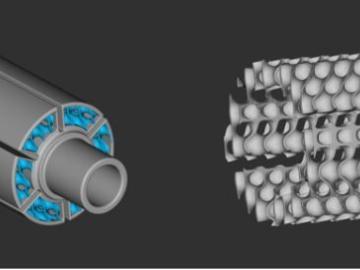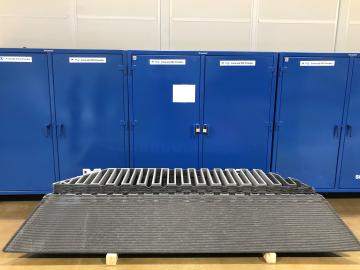
Filter News
Area of Research
- (-) Energy Science (88)
- (-) Neutron Science (23)
- Advanced Manufacturing (5)
- Biology and Environment (38)
- Building Technologies (2)
- Computational Engineering (3)
- Computer Science (12)
- Electricity and Smart Grid (1)
- Energy Frontier Research Centers (1)
- Energy Sciences (1)
- Fusion and Fission (3)
- Fusion Energy (2)
- Isotopes (2)
- Materials (67)
- Materials for Computing (11)
- Mathematics (1)
- National Security (18)
- Nuclear Science and Technology (3)
- Quantum information Science (4)
- Sensors and Controls (2)
- Supercomputing (67)
News Type
News Topics
- (-) Computer Science (22)
- (-) Grid (24)
- (-) Nanotechnology (12)
- (-) Physics (9)
- (-) Quantum Science (5)
- (-) Security (4)
- 3-D Printing/Advanced Manufacturing (54)
- Advanced Reactors (3)
- Artificial Intelligence (7)
- Big Data (3)
- Bioenergy (18)
- Biology (11)
- Biomedical (10)
- Biotechnology (4)
- Buildings (21)
- Chemical Sciences (12)
- Clean Water (5)
- Composites (15)
- Coronavirus (11)
- Critical Materials (8)
- Cybersecurity (4)
- Energy Storage (49)
- Environment (30)
- Exascale Computing (2)
- Fossil Energy (1)
- Frontier (2)
- Fusion (2)
- High-Performance Computing (4)
- Hydropower (2)
- Isotopes (1)
- Machine Learning (6)
- Materials (36)
- Materials Science (35)
- Mathematics (1)
- Mercury (2)
- Microscopy (7)
- Molten Salt (1)
- National Security (5)
- Neutron Science (63)
- Nuclear Energy (6)
- Partnerships (8)
- Polymers (10)
- Simulation (2)
- Space Exploration (4)
- Statistics (1)
- Summit (5)
- Transportation (45)
Media Contacts

Additive manufacturing can make the design and production of specialized tools for geothermal energy cheaper and more efficient, according to a study by Oak Ridge National Laboratory.

A team of researchers at Oak Ridge National Laboratory has developed a method to detect and measure air leaking from a building’s walls and roof that is quicker, cheaper and less disruptive to occupants.

A research team led by Oak Ridge National Laboratory bioengineered a microbe to efficiently turn waste into itaconic acid, an industrial chemical used in plastics and paints.

Oak Ridge National Laboratory researchers, in collaboration with Cincinnati Inc., demonstrated the potential for using multimaterials and recycled composites in large-scale applications by 3D printing a mold that replicated a single facet of a

Using complementary computing calculations and neutron scattering techniques, researchers from the Department of Energy’s Oak Ridge and Lawrence Berkeley national laboratories and the University of California, Berkeley, discovered the existence of an elusive type of spin dynamics in a quantum mechanical system.

Researchers at Oak Ridge National Laboratory have identified a statistical relationship between the growth of cities and the spread of paved surfaces like roads and sidewalks. These impervious surfaces impede the flow of water into the ground, affecting the water cycle and, by extension, the climate.

Xin Sun has been selected as the associate laboratory director for the Energy Science and Technology Directorate, or ESTD, at the Department of Energy’s Oak Ridge National Laboratory.

A method developed at Oak Ridge National Laboratory to print high-fidelity, passive sensors for energy applications can reduce the cost of monitoring critical power grid assets.

Energy storage startup SPARKZ Inc. has exclusively licensed a battery cycling technology from ORNL designed to enable the rapid production of lithium-ion batteries commonly used in portable electronic devices and electric vehicles.

A new Department of Energy report produced by Oak Ridge National Laboratory details national and international trends in hydropower, including the role waterpower plays in enhancing the flexibility and resilience of the power grid.


